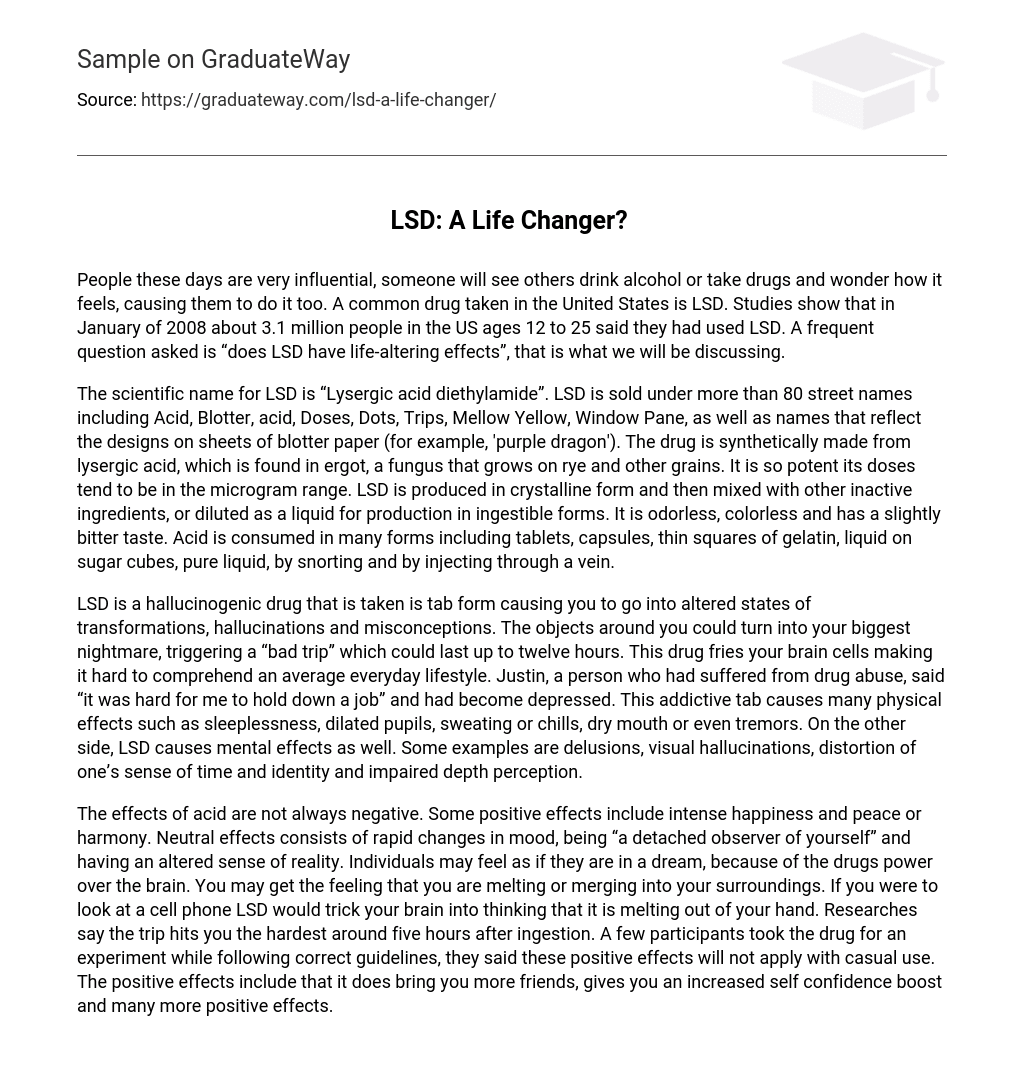People these days are very influential, someone will see others drink alcohol or take drugs and wonder how it feels, causing them to do it too. A common drug taken in the United States is LSD. Studies show that in January of 2008 about 3.1 million people in the US ages 12 to 25 said they had used LSD. A frequent question asked is “does LSD have life-altering effects”, that is what we will be discussing.
The scientific name for LSD is “Lysergic acid diethylamide”. LSD is sold under more than 80 street names including Acid, Blotter, acid, Doses, Dots, Trips, Mellow Yellow, Window Pane, as well as names that reflect the designs on sheets of blotter paper (for example, ‘purple dragon’). The drug is synthetically made from lysergic acid, which is found in ergot, a fungus that grows on rye and other grains. It is so potent its doses tend to be in the microgram range. LSD is produced in crystalline form and then mixed with other inactive ingredients, or diluted as a liquid for production in ingestible forms. It is odorless, colorless and has a slightly bitter taste. Acid is consumed in many forms including tablets, capsules, thin squares of gelatin, liquid on sugar cubes, pure liquid, by snorting and by injecting through a vein.
LSD is a hallucinogenic drug that is taken is tab form causing you to go into altered states of transformations, hallucinations and misconceptions. The objects around you could turn into your biggest nightmare, triggering a “bad trip” which could last up to twelve hours. This drug fries your brain cells making it hard to comprehend an average everyday lifestyle. Justin, a person who had suffered from drug abuse, said “it was hard for me to hold down a job” and had become depressed. This addictive tab causes many physical effects such as sleeplessness, dilated pupils, sweating or chills, dry mouth or even tremors. On the other side, LSD causes mental effects as well. Some examples are delusions, visual hallucinations, distortion of one’s sense of time and identity and impaired depth perception.
The effects of acid are not always negative. Some positive effects include intense happiness and peace or harmony. Neutral effects consists of rapid changes in mood, being “a detached observer of yourself” and having an altered sense of reality. Individuals may feel as if they are in a dream, because of the drugs power over the brain. You may get the feeling that you are melting or merging into your surroundings. If you were to look at a cell phone LSD would trick your brain into thinking that it is melting out of your hand. Researches say the trip hits you the hardest around five hours after ingestion. A few participants took the drug for an experiment while following correct guidelines, they said these positive effects will not apply with casual use. The positive effects include that it does bring you more friends, gives you an increased self confidence boost and many more positive effects.
The history of this drug is intriguing. A man named Albert Hofman, was the first person to synthesize the drug in 1938. Hofman was a Swiss chemist who accidentally found its hallucinogenic properties when he invested some through his skin in 1943. Over the next 15 years acid was used as a drug to support psychoanalysis then in the 1960s LSD was used for recreational purposes. Tales of the drugs effects started to swarm the media, stopping the production. In 1967, Acid was banned and classified as a Schedule 1 drug with no acceptable medical use. Acid’s popularity has decreased since the 1970’s.
This powerful hallucinogen can, if taken regularly enough, lead to cross-tolerance with other hallucinogenic drugs like mescaline, psilocybin, and DMT. Some medical researchers are considering whether microdosing LSD could become a future treatment for chronic depression, anxiety, and bipolar disorder; however, since LSD is abused now, it is unpredictable and can cause serious problems. Acid can cause bad trips which can include anxiety, panic attacks, delusions, paranoia, not knowing one’s identity, and many more. More general psychedelic effects include changes to senses, altered time sense, depersonalization and feeling like one’s having a “spiritual” experience.
It’s believed that LSD works similarly to serotonin, a neurotransmitter responsible for regulating moods, appetite, muscle control, sexuality, sleep and sensory perception. Mellow Yellow seems to alter the way the brain’s serotonin receptors work. It may inhibit neurotransmission, stimulate it, or both. It also affects the way that the retinas process information and conduct that information to the brain. As little as 0.25 micrograms of LSD per 2.2 pounds (about 1 kilogram) of body weight causes trips, and that’s a fairly standard modern dose. In the 1960’s people were ingesting about four times the modern dose. When someone takes acid it digests into their lives then quickly moves to the brain and urine. A little bit is left by the end of the trip, but will be completely out of one’s system in about two weeks.
LSD is a life altering drug. After doing extensive research it is clear that the drug can and will fry your brain or cause you to be in a permanent transformed state of mind. Acid is not a drug to mess around with.





